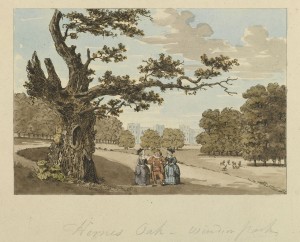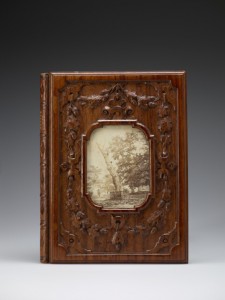A Shakespearean ghost and an old tree

Herne’s Oak, Windsor Park circa 1799
Etching with hand colouring, attributed to Samuel Ireland (1744-1800). The two Merry Wives of Windsor, Mistress Page and Mistress Ford, are standing with Falstaff at Herne’s Oak.
Drawings Gallery, Windsor Castle
Royal Collection Trust/© Her Majesty Queen Elizabeth II 2016
In the grounds of Windsor Castle in England stand thousand-year-old oaks so huge and gnarled and blasted it’s easy to imagine them haunted by spirits. Shakespeare used this conceit in his play “The Merry Wives of Windsor.”
When I was a Windsor wife in the early 1960s , I attended a performance by the Windsor Repertory Theatre of “Merry Wives” one summer evening in the castle gardens. Probably written to amuse Queen Elizabeth I, the play uses as its setting then-familiar Windsor landmarks, such as the 14th century Garter Inn on High Street and Herne’s Oak in Windsor Great Park.
The play centers around the drinker and gambler Sir John Falstaff, known from the plays Henry IV part 1 and part 2. Short of money, he comes to Windsor where he attempts to seduce both Mistress Page and Mistress Ford in hope that at least one of them will share her husband’s wealth with him. He writes each wife an identical letter, but the two women, who are close friends, immediately show each other their letters and are outraged.
The wives decide to teach Falstaff a lesson, and pretend to lead him on while planning his downfall. He is dumped from a laundry basket into the muddy River Thames, and beaten while disguised as the Old Woman of Brentford, who is believed to be a witch. With their husbands in on the secret, they concoct a final revenge for his clumsy insults to their virtue. Mistress Page sets the scene:
There is an old tale goes that Herne the hunter,
Sometime a keeper here in Windsor Forest,
Doth all the winter-time, at still midnight,
Walk round about an oak, with great ragg’d horns;
And there he blasts the tree, and takes the cattle,
And makes milch-kine yield blood, and shakes a chain
In a most hideous and dreadful manner.
You have heard of such a spirit, and well you know
The superstitious idle-headed eld
Receiv’d, and did deliver to our age,
This tale of Herne the hunter for a truth.

Cover of William Perry’s “A Treatise on the Identity of Herne’s Oak, Shewing the Maiden Tree to Have Been the Real One”
Probably presented to Queen Victoria by William Perry, c. 1867
Drawings Gallery, Windsor Castle
Royal Collection Trust/© Her Majesty Queen Elizabeth II 2016
The Royal Collection website notes:
Perry’s treatise claiming the authenticity of this tree echoed Queen Victoria’s own belief, though his view was not entirely unbiased since he had been given portions of the wood to carve into souvenirs, which include the binding of this book. A photograph of the tree shortly before its fall is inserted in the front board.
Falstaff is induced to dress as the ghost of Herne the Hunter and wait for the two women at Herne’s Oak, where he is pinched and tormented by local children dressed up as fairies.
Since Herne’s Oak has now fallen, exactly which tree it was—the one that fell in 1799 or the one in 1863—remains in dispute. Also unclear and undocumented are the origins of the myths about Herne the Hunter. Shakespeare was the first writer to mention him. His purported connection to ancient archetypes representing the primal power of nature may be an artifact of Victorian story-makers. Some evidence suggests there was a real game-keeper in Windsor Great Park named Herne or Horne, possibly in Elizabeth I’s time, possibly earlier, who, having committed some great offence for which he feared a dreadful punishment, hanged himself on an oak tree. Maybe Mistress Page had it right: the memory of such an event at a scary-looking tree could be enough to start a legend about a ghost.

HI Maureen,
Finally got around to read of your fascinating tale of the play you saw, “The Merry Wives of Windsor”.
Your writing and descriptive passages make it come alive.
Thank you
Alice
Stories from the ancient castles are entertaining and colorful. I enjoy the historical adventures (true or fictional) and I am sure there is some truth in each, Thank you
Hi Maureen,
“The Merry Wives of Windsor” was one of Shakespeare’s plays that we did not cover when at college but I have read it many times since. I had a fixation for Shakespeare when I was feeding babies at different times ( yes you may laugh) and I read all of his plays in my rather large volume of his plays from cover to cover. I also was lucky enough, while living in Christchurch, to go to the new Ngaio Marsh Theatre – a theatre in the round, to see a production of “The Merry Wives of Windsor” and enjoyed every minute of it. Thank you for the history as such of Herne the Hunter and the oak tree. I did not know any of this.
I also enjoyed your story about the cuckoo. In NZ I always knew it as the shining cuckoo and yes the habit of taking over another bird’s nest was the same there. After I moved from the Gold Coast to Brisbane in Australia I was living in the suburb of Fig Tree Pocket next to a bush land reserve. I had the joy of having a cuckoo calling from a tree in my back yard and an answering one from the same bush area some 50m away. Spring time was in the air and leaves were emerging from branches and eggs were being laid in newly made nests. Dare I say it? On this one morning, where there was a pee wee’s nest with young, I was horrified to witness an attack by a cuckoo attempting to push the young fledglings out of their nest. The cuckoo was attacked again and again by the pee wee but to no avail and even when help from the pee wee’s mate arrived, the odds of the much smaller birds’ defense succeeding in fending the cuckoo off, were stacked against them. First one chick fell then another and then another. The whole drama was over in thirty minutes and quiet descended. Two weeks later the new family of cuckoos sounded their calls of coo-ccuckoo, later followed by the sound of cheeping. Life goes on.